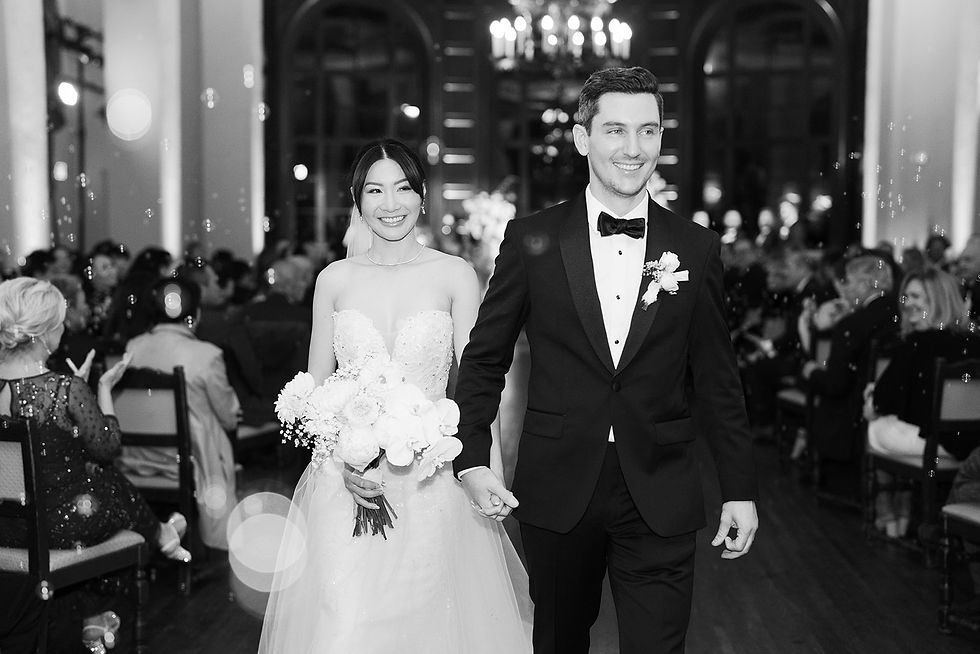How to Have a Vietnamese Wedding Tea Ceremony?
- Songbird

- Mar 7
- 4 min read
A Vietnamese wedding tea ceremony is a cherished tradition in Vietnamese culture. It is a moment when two families come together to honor their families and receive blessings for a long and happy marriage.
If you’re a Vietnamese American bride or groom-to-be looking to incorporate this beautiful tradition into your wedding, but you’re not sure where to start, you’re in the right place! This guide will walk you through each step of the Vietnamese tea ceremony, from preparation to execution, so you can host an elegant and meaningful celebration.
What is a Vietnamese Tea Ceremony?
The Vietnamese tea ceremony, or "Lễ Vu Quy" (Bride’s Family Ceremony) and "Lễ Thành Hôn" (Groom’s Family Ceremony), is a traditional engagement and wedding ritual where families formally acknowledge the marriage.
The ceremony begins when the groom’s family arrives at the bride’s home with red trays filled with symbolic gifts. The couple serves tea to their elders, receives blessings, and offers prayers at the ancestor altar.

Step-by-Step Guide to a Vietnamese Wedding Tea Ceremony

Step 1: Setting Up the Ceremony Space
Traditionally, the tea ceremony is hosted at the bride’s family home, but it can also take place in a wedding venue, garden, or hotel. A dedicated space should be set up with:
A beautifully decorated ancestor altar with candles, flowers, incense, and framed photos of ancestors.
A table for serving tea, decorated with an elegant tea set and floral arrangements.
Seating for parents, grandparents, and close family members who will receive the tea.
Décor Tip: Red and gold are the most auspicious colors in Vietnamese culture, symbolizing luck, happiness, and prosperity. Incorporate these colors into your flowers, table settings, and dress choices!

Step 2: The Groom’s Arrival & Gift Presentation
The tea ceremony begins when the groom and his family arrive at the bride’s home, carrying Lễ Vật (wedding gifts) in large Mam qua (Red Trays) covered with red fabric. These gifts usually include:
Baskets:
1. The Betel and Areca Basket (Symbol of Commitment)
Betel leaves and areca nuts (symbolizing a strong and lasting marriage) If these are unavailable, a well-presented substitute like chewing tobacco.
2. The Drink Gift Basket (Symbol of Celebration)
This is usually Liquor (2 bottles, must be in pairs) or Tea (2 sets, must be in pairs)
3. The Wealth Gift Basket (Symbol of Prosperity)
This is usually money or gold jewelry or gold bars. This basket can be as extravagant as desired to impress the bride’s family
4. The Sweets Basket (Symbol of Sweetness in Marriage)
Small, beautifully packaged cakes in pairs. Traditionally, "Bánh phu thê" (Husband & Wife Cake), but any sweet cake will do.
5. The Fruits Basket (Symbol of Abundance)
Common choices include oranges, apples, dragon fruit, grapes, or pears.
Optional Extras
6. The Jewelry Basket (Symbol of Love & Future Security)
Gold jewelry for the bride, typically a necklace, bracelet, or bangles.
7. The Roasted Pig Basket (Symbol of a Prosperous Union)
A whole roasted pig. This represents wealth, celebration, and abundance.
The number of baskets must be odd; 5 or 7 is the norm, and gifts must come in pairs. Some families opt for a more minimalistic approach by replacing traditional offerings with Western-style gifts or personal tokens of love.

Step 3: Paying Respect at the Ancestor Altar
Once the gifts have been presented, the couple moves to the ancestor altar to light incense and bow in prayer. This is a deeply spiritual moment, where they ask for blessings from their ancestors and honor their family roots.

Step 4: Serving Tea to Elders & Receiving Blessings
The heart of the ceremony is the tea-serving ritual, where the bride and groom kneel and present tea to their elders, starting with their parents, then grandparents, and other close relatives.
Serving Order: 1. Parents of the bride & groom 2. Grandparents & other elder family members 3. Aunts, uncles, and extended family

Step 5: The Gifting of Jewelry
In many Vietnamese weddings, this is the moment when: The groom’s parents gift the bride gold jewelry, usually a necklace or bangles, as a symbol of her new status in the family.


Step 6: Closing the Ceremony & Celebrating
After all the elders have been served tea, family photos are taken, and the ceremony concludes with a meal to celebrate the couple’s new beginning.
🥂 Some families opt for a small home-cooked feast, while others book a private banquet with traditional Vietnamese dishes like roasted pig, banh xeo, and sticky rice.
Depending on your preferences, you have the option of going to the groom's house and repeating the process from step 3 onward for the groom's side of the family.

What to Wear to a Vietnamese Tea Ceremony
👰 For the Bride: A traditional Áo dài in red, gold, or soft pastels, often with intricate embroidery or floral details.
🤵 For the Groom: A coordinating Áo dài or Áo gam or a classic Western suit, depending on preference.
👨👩👧👦 For Family & Guests: Bridesmaids and groomsmen often wear matching Áo dài for a beautifully coordinated look.
No matter how you choose to celebrate, the Vietnamese tea ceremony is a beautiful way to honor your heritage, connect with family, and start your new chapter with love and respect.
Planning a Vietnamese Tea Ceremony? Let’s Make It Unforgettable!
Whether you’re blending cultures or embracing your roots, planning a tea ceremony can feel overwhelming. Work with a wedding planner who specializes in Vietnamese traditions to bring your vision to life with elegance and ease.
✉️ Need help planning your dream Vietnamese wedding? Let’s chat about making your celebration unique and stress-free!
For more personalized information, book a consultation
For Inspiration and advice follow us on Instagram




Comments